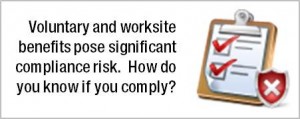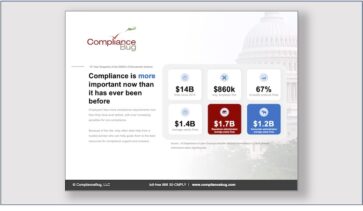Worksite and voluntary benefits have become a hot area for brokers, consultants and employers as a way to cope with healthcare reform’s impact on their businesses. To alleviate the administrative burdens incurred by employers when offering voluntary benefits, carriers and brokers typically offer “incentives” like enrollment systems, employee communications and data audits. These incentives often sway employers to offer one set of voluntary benefits over another. However, these incentives can subject the employer to significant compliance risk including fines and penalties by the IRS and DOL and possible civil action by current and former employees.

What’s the problem?
To be considered exempt from the numerous requirements of ERISA compliance, many employers incorrectly believe they only need to make the benefit 100% voluntary. However, to be considered exempt under ERISA’s voluntary plan safe harbor, several requirements must be met. These require the plan to:
-
- be completely voluntary,
- not allow employer contributions,
- not allow the employer to endorse the plan, and
- not allow the employer to receive consideration for collecting and remitting premiums (other than reasonable compensation)
While the above requirements are fairly straight-forward, they aren’t the only requirements. Incorrectly performing any of the below could disqualify the benefit from the safe harbor provisions (see Butero v. Royal Maccabees Life Insurance Co.):
-
- having the employer involved in the insurer selection process
- negotiating Plan terms/linking coverage to employee status
- using employer’s name/associating plan with other employee Plans
- recommending Plan to employees
- saying ERISA applies
- doing more than permitted payroll deductions
- allowing use of employer Cafeteria Plan
- assisting employee with claims or disputes
How does this apply to my organization?
Based on employer self-reporting, ComplianceBug uncovered a substantial number of employers inadvertently performing the above mentioned functions which, potentially, could disqualify the plans from ERISA exemption. Examples of common mistakes include exclusively notifying the carrier of newly eligible employees, issuing exclusive enrollment reminders via email (considered endorsement) and receiving additional services from brokers which can be considered “compensation”.
Other examples include the employer taking “credit” for the plan, including the employer’s logo on communication materials, and assisting with “marketing” the plan. Often times, the broker or carrier encourage the employer to “endorse” the plan, without which participation and enrollment would be next to nothing.
Another typically non-compliant area is in how employers handle payroll deductions. Segregating employee withholdings from the general assets of the employer creates a “funded” plan status subjecting the plan to ERISA provisions including trust and bonding requirements in addition to plan reporting and documentation disclosures.
What’s the risk?
Fines and penalties can accrue quickly. Employers and their owners can be liable for tens or hundreds of thousands of dollars if they are considered to be sponsoring an ERISA plan without following the required provisions. These include:
- requirement to pay claims (carrier doesn’t have to)
- punitive and consequential damages as determined by the courts
- $149 per day penalty for failing to provide Plan Document and SPD
- $2,097 per plan per day for failing to prepare and file Form 5500
The above financial risk typically arises when a current or former employee sues if they believe they haven’t received benefits they are entitled to. Courts will weigh whether or not the employer’s control over the terms of a benefit plan make it subject to ERISA. Actions by the employer (such as administering the plan, receiving a financial benefit from offering the plan, endorsement, etc.) will cause the courts to find the employer has fiduciary responsibility for the plan and is subject to ERISA. Additional fines and penalties can levied (e.g., 2006 case Moorman v. Unum Provident Corp.) in addition to requiring the employer to remit for the benefits claimed.
On top of that, ERISA requires employers to have plan documents, distribute SPD’s and, depending on the number of participants, file Form 5500’s annually.
How do I fix possible issues with my worksite and voluntary benefits?
One way to avoid compliance risk would be for employers to completely remove themselves from the administrative burden of voluntary/worksite benefits. For example, staying out of the process for payroll withholding eliminates the need for administrative/enrollment systems and other special communications which can be considered “compensation” under ERISA.
Alternatively, because ERISA preempts state laws, there are benefits to the employer to say the plan is subject to ERISA. Often, if sued, only the benefits are recovered and there are no punitive or consequential damages that could be awarded to a beneficiary.
ComplianceBug strongly encourages employers and their advisors to proactively assess their level of risk and consider working with a knowledgeable ERISA professional who can help ensure the necessary requirements under ERISA are followed.
For more information on assessing compliance risk, call 866 30-CMPLY (26759) or visit www.compliancebug.com.




